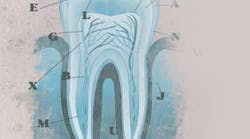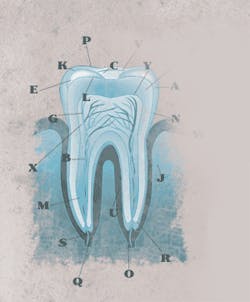Blood testing in the dental office
by Shirley Gutkowski, RDH, BSDH, FACE
Part 9 of 10
By now, you're getting the hang of the idea about the philosophy of minimal intervention dental hygiene (MIDH). It started out about keeping the enamel amputations small. It's moving right up the chain to earlier diagnostics, and diagnosis during all other dental procedures and therapies. One that needs a little explanation is the evolution of diagnosis and treatment of periodontal infections.
I'd like to start with a little lesson about the changes during the last decade pertaining to periodontal infections and the relationship they have with the whole body. I'd like to direct you to pubmed.gov for more background information. Use the search strings starting with the word periodontal, and one of these words after it: cardiac, cardiovascular, COPD, CVD, stroke, brain attack, heart attack, C-reactive proteins, or diabetes. This should get you started on the path to understanding the seriousness of this infection.
It's not really the periodontal infection that's cause for concern. Now pick your chin up off the floor — it's not the fact that the infection is in the mouth. The problem stems from any untreated infection in the body. That is fact number one to be brought to the light of day. To state it more clearly: any infection in the body that is left untreated will increase the risk of the big seven: COPD, cardiovascular disease, stroke, preterm birth, low birth weight, arthritis, and diabetes (so far). Periodontal disease is the easiest infection to detect, diagnose, and treat in the dental office, as opposed to detecting an infected appendix in the dental office.
You can see that with the list of serious comorbidity factors associated with the periodontal infection, we can no longer look at the bent wire as a diagnostic tool. There are too many ways to create a false positive reading, and too many confounding factors, primarily diabetes, that can cause bleeding of the sulcus.
The American Academy of Periodontology suggests that a lack of bleeding on probing indicates health, not that bleeding on probing indicates disease. Those few hygienists who practice ahead of the curve and used the Diamond Probe earlier this millennium to detect VSCs in the sulcus (volatile sulfur compounds associated with tissue destruction) learned that tissue destruction can occur in a healthy looking 2 mm sulcus.
The bent wire no longer has a place in the operatory, at least not for periodontal disease diagnosis. What we need in dental hygiene right now is chairside blood testing. Now settle down, it's not that big a deal! Let's remember that dentistry is a health profession, not an enamel scraping or cutting profession. We all studied blood chemistry in college, and we had blood chemistry questions on our boards. Most hygienists swim in blood all day.
The primary blood readings we need are inflammatory markers. We can do that in at least one chairside test called TOPAS; however, the most important marker is CRP. It is what all the studies measure, including those that find elevated CRP numbers, which are a better risk indicator for a cardiovascular event than cholesterol. Read that again.
The second most important is the HgA1c number that reflects the average blood sugar level over a period of three months. Nearly as many people don't know they have diabetes as know they do. This is a huge confounder for current periodontal infection diagnosis.
One way to get blood results is to send the patient to the local lab. Another is to simply do it at the office. Anyone with bleeding upon probing should have blood work to eliminate the potential for comorbidity, and it's a better starting point than pocket depth readings. Pockets are a surrogate measure of disease, a history lesson. They don't tell if the disease is active or not.
Once you have a baseline of at least CRP and HgA1c, you can take some action. A high glucose reading will tell you that the patient needs to see his or her physician for an evaluation. A high CRP should fall dramatically after periodontal treatment. If it doesn't, a trip to the physician is in order. Practices that do in-office blood testing have found patients with everything from gout to colon cancer.
These two safe and easy tests can be done in the office. The dentist-inspired tests can be found at www.hearthealthydentistry.com. A simple finger prick (that patients can do themselves) and three drops of blood on a card is the first step. The second step is to send the card to a specialized lab for testing, and the third is to take the faxed information and incorporate it into the patient's chart.
If they have a high reading in any of the tests, a referral is indicated. For us, it's a screening; for them it's a test. Some dentists don't like the idea because it's too close to practicing medicine. Well, we can argue that we practice medicine every day. By treating bleeding gums as a periodontal infection when the bleeding really is a presentation of uncontrolled diabetes, we're malpracticing, if you'll pardon the coined word. Last year DentalLawyers.com advertised on Google to people searching "gum disease." We're not talking a difference of opinion here. We're talking patients finding malpractice attorneys to win cases for not only losing teeth, but for having heart attacks, strokes, and more.
Look into it. Be aware. Minimal intervention rests on early diagnosis and treatment based on a diagnosis. Look into medical billing, too. Another impasse to dental office blood testing is reimbursement. If your patient has what appears to be a periodontal infection, and you have a blood test to show that your treatment affected the physical health of the patient, it may be that your patient's medical insurance will cover your treatment. But this cannot be done without a diagnosis and a diagnosis code.
The future may hold other options for diagnostic tools. Saliva has promise, and I still have my fingers crossed for a way to detect destruction at the site. Don't rule out the DNA test by Oratec to detect the gene associated with periodontal disease. There is a PreViser risk assessment tool, too. To get all of this diagnosis done in an appointment, it may be that a new type of team member called a risk factor manager will need to be incorporated into the team. Ah, the doors are opening!
About the Author
Shirley Gutkowski, RDH, BSDH, FACE, is codirector of CareerFusion and a practicing dental hygienist. She is coauthor of the best-selling book The Purple Guide: Developing Your Clinical Dental Hygiene Career with Amy Nieves, RDH. She can be contacted at [email protected].







